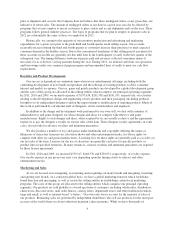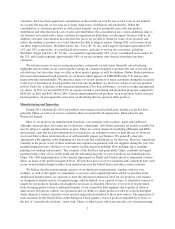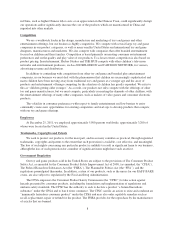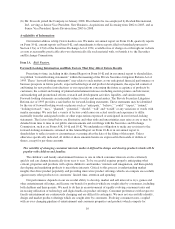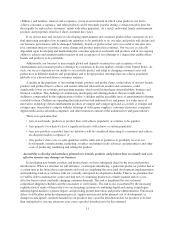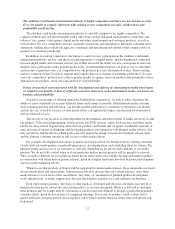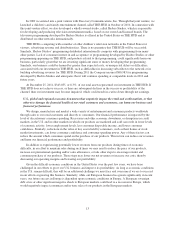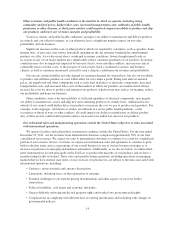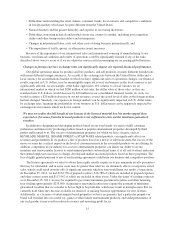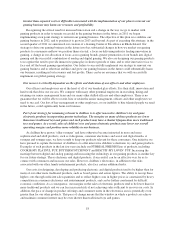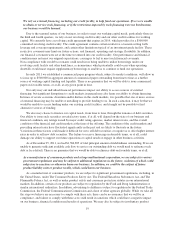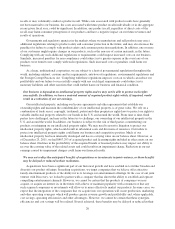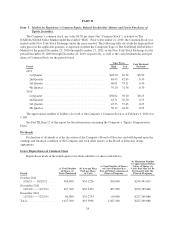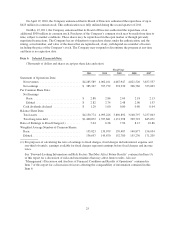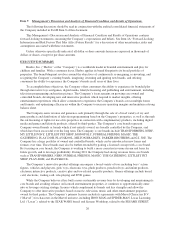Hasbro 2011 Annual Report Download - page 25
Download and view the complete annual report
Please find page 25 of the 2011 Hasbro annual report below. You can navigate through the pages in the report by either clicking on the pages listed below, or by using the keyword search tool below to find specific information within the annual report.We anticipate that the shorter theatrical duration for movie releases may make it increasingly difficult for us
to profitably sell licensed products based on entertainment properties and may lead our customers to reduce their
demand for these products in order to minimize their inventory risk. Furthermore, there can be no assurance that
a successful brand will continue to be successful or maintain a high level of sales in the future, as new
entertainment properties and competitive products are continually being introduced to the market. In the event
that we are not able to acquire or maintain successful entertainment licenses on advantageous terms, our revenues
and profits may be harmed.
Our business is seasonal and therefore our annual operating results will depend, in large part, on our sales
during the relatively brief holiday shopping season. This seasonality is exacerbated by retailers’ quick
response inventory management techniques.
Sales of our toys, games and other family entertainment products at retail are extremely seasonal, with a
majority of retail sales occurring during the period from September through December in anticipation of the
holiday season, including Christmas. This seasonality has increased over time, as retailers become more efficient
in their control of inventory levels through quick response inventory management techniques. Customers are
timing their orders so that they are being filled by suppliers, such as us, closer to the time of purchase by
consumers. For toys, games and other family entertainment products which we produce, a majority of retail sales
for the entire year generally occur in the fourth quarter, close to the holiday season. As a consequence, the
majority of our sales to our customers occur in the period from September through December, as our customers
do not want to maintain large on-hand inventories throughout the year ahead of consumer demand. While these
techniques reduce a retailer’s investment in inventory, they increase pressure on suppliers like us to fill orders
promptly and thereby shift a significant portion of inventory risk and carrying costs to the supplier.
The limited inventory carried by retailers may also reduce or delay retail sales, resulting in lower revenues
for us. If we or our customers determine that one of our products is more popular at retail than was originally
anticipated, we may not have sufficient time to produce and ship enough additional product to fully capture
consumer interest in the product. Additionally, the logistics of supplying more and more product within shorter
time periods increases the risk that we will fail to achieve tight and compressed shipping schedules, which also
may reduce our sales and harm our financial performance. This seasonal pattern requires significant use of
working capital, mainly to manufacture or acquire inventory during the portion of the year prior to the holiday
season, and requires accurate forecasting of demand for products during the holiday season in order to avoid
losing potential sales of popular products or producing excess inventory of products that are less popular with
consumers. Our failure to accurately predict and respond to consumer demand, resulting in our underproducing
popular items and/or overproducing less popular items, would reduce our total sales and harm our results of
operations. In addition, as a result of the seasonal nature of our business, we would be significantly and adversely
affected, in a manner disproportionate to the impact on a company with sales spread more evenly throughout the
year, by unforeseen events, such as a terrorist attack or economic shock, that harm the retail environment or
consumer buying patterns during our key selling season, or by events, such as strikes or port delays, that interfere
with the shipment of goods, particularly from the Far East, during the critical months leading up to the holiday
purchasing season.
The concentration of our retail customer base means that economic difficulties or changes in the purchasing
or promotional policies or patterns of our major customers could have a significant impact on us.
We depend upon a relatively small retail customer base to sell the majority of our products. For the fiscal
year ended December 25, 2011, Wal-Mart Stores, Inc., Toys “R” Us, Inc. and Target Corporation, accounted for
approximately 20%, 11% and 10%, respectively, of our consolidated net revenues and our five largest customers,
including Wal-Mart, Toys “R” Us and Target, in the aggregate accounted for approximately 45% of our
consolidated net revenues. In the U.S. and Canada segment, approximately 68% of the net revenues of the
segment were derived from our top three customers. If one or more of our major customers were to experience
difficulties in fulfilling their obligations to us, cease doing business with us, significantly reduce the amount of
their purchases from us, favor competitors or new entrants, increase their direct competition with us by
expanding their private-label business, change their purchasing patterns, alter the manner in which they promote
16


